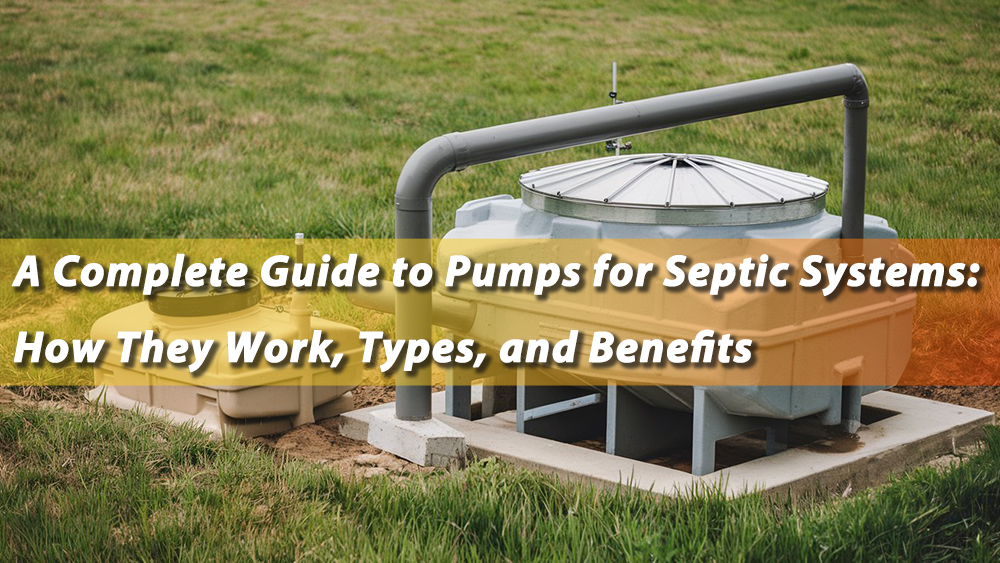+86 13816508465
Apr. 22, 2025

Septic systems play a critical role in managing wastewater in residential and commercial properties that are not connected to municipal sewer systems. While many traditional systems rely on gravity, today’s complex site conditions often require pump-assisted solutions to ensure effective and safe wastewater treatment. Whether you're a homeowner, contractor, or wastewater system designer, understanding how pumps work in septic systems is essential.
This guide offers a deep dive into septic system configurations, the differences between gravity-fed and pump-assisted systems, the types of pumps involved, and how to select the best pump for your needs.
Understanding Septic Systems: Gravity vs. Pump-Assisted
1. Gravity-Fed Septic Systems
In a standard gravity-fed septic system, wastewater flows from the house to the septic tank and then continues to a drain field or soil absorption system using the natural force of gravity. These systems are simple, cost-effective, and require minimal mechanical components. However, they depend heavily on favorable site conditions:
The drain field must be located at a lower elevation than the septic tank.
The soil must allow for proper percolation and absorption.
The installation site must have an adequate slope.
When these conditions are not met, gravity alone is insufficient—this is where pump-assisted systems come in.
2. Pump-Assisted Septic Systems
Pump-assisted (or pressure) systems are used when gravity drainage is impossible or inefficient—such as in flat terrain, high groundwater areas, or when the drain field is uphill from the septic tank. In these systems, pumps move either raw sewage or treated effluent to the next stage of the system.
Pump-assisted systems offer multiple benefits:
Site Flexibility: They allow septic systems to be installed in areas where traditional gravity systems wouldn't work.
Smaller Pipes: Because of the pressure created by the pump, smaller-diameter pipes can be used, lowering installation costs.
Efficient Distribution: Some systems use timed or dosed pumping to distribute effluent evenly into the drain field, improving long-term soil health.
Common Pump Types Used in Septic Systems
Choosing the correct type of pump is crucial for the system’s functionality and longevity. Below are the main pump types used in different stages of a septic system:
1. Sewage Ejector Pumps
Purpose: Pump raw sewage from toilets and other drains when the plumbing is below the level of the main septic line (e.g., in basements).
Function: Moves solid waste and wastewater to the septic tank or sewer line.
Key Feature: Can handle solids up to 2 inches in diameter.
2. Effluent Pumps
Purpose: Move liquid effluent (partially treated wastewater) from the septic tank to the drain field.
Function: Used when the drain field is at a higher elevation or a considerable distance from the tank.
Key Feature: Handles clear, solid-free liquid; not suitable for raw sewage.
3. Grinder Pumps
Purpose: Grind and pump raw sewage when elevation or long distance makes gravity drainage impossible.
Function: Reduce solids into a slurry, allowing them to be pumped through narrow pipes to a treatment facility or drain field.
Key Feature: Ideal for properties with difficult layouts or shared systems (e.g., in small communities or subdivisions).
Key Components of a Pump-Assisted Septic System
A modern pump-assisted septic system may consist of the following:
Septic Tank: Where solids settle and initial treatment occurs.
Pump Chamber: A separate tank or a compartment where a pump sits, triggered by float switches.
Float Switches: Control when the pump activates based on the water level.
Control Panel: Manages pump cycles and provides alarms in case of malfunction.
Drainfield or Pressure Dosing Field: Where treated effluent is discharged.
Advantages of Pump-Assisted Septic Systems
Pump-assisted systems aren’t just necessary—they can be advantageous, especially when designed properly:
1. Enables Use in Difficult Terrains: Properties with high water tables or no slope can still install efficient septic systems.
2. Improves Effluent Distribution: Timed or dosed release prevents overloading one part of the drain field.
3. Compact System Design: Allows for smaller or more strategically placed drainfields.
4. Increased Treatment Efficiency: Some advanced pump systems integrate filtration and aeration, enhancing the biological treatment process.
Factors to Consider When Choosing a Septic Pump
Selecting the right pump depends on your system configuration and wastewater characteristics:
Factor | Consideration |
Type of Wastewater | Raw sewage (use grinder/ejector); effluent only (use effluent pump) |
Vertical Lift (Head) | How far vertically the pump must lift the wastewater |
Horizontal Distance | Total length of pipe the pump must push wastewater through |
Flow Rate | How much wastewater needs to be moved per minute/hour |
Power Supply | Single-phase or three-phase depending on location and pump size |
Durability | Look for corrosion-resistant materials, especially for wet wells |
Maintenance Tips for Pump-Equipped Septic Systems
Proper maintenance will extend the life of your system and prevent costly failures:
Pump Inspection: Test pump function and float switch every 6–12 months.
Alarm System: Make sure the high-water-level alarm is working.
Septic Tank Pumping: Every 3–5 years depending on household size and water use.
Avoid Flushing Solids: Don’t flush grease, hygiene products, or wipes.
Winterization: In cold climates, insulate or install frost-resistant components.
Conclusion: Planning for a Healthy Septic System
Whether you're installing a new system or upgrading an old one, understanding the role of pumps in septic systems is essential. From handling elevation challenges to improving wastewater distribution, pumps make modern septic systems more flexible and efficient.
Consulting with a qualified wastewater professional will help you select the right pump type, capacity, and configuration for your specific site and usage needs. With proper design, installation, and maintenance, your pump-assisted septic system can offer reliable and environmentally friendly wastewater treatment for decades.
Address
No.17 XeDa Jimei Ind. Park, Xiqing Economic Development Area, Tianjin, China
Telephone
+86 13816508465
QUICK LINKS